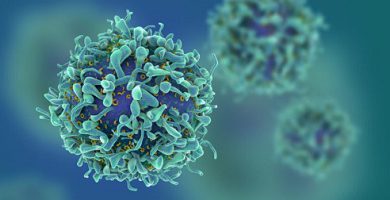What is a eukaryotic cell?
We explain what a eukaryotic cell is, the types that exist and their functions. In addition, its parts and differences with a prokaryotic cell.
-
What is a eukaryotic cell?
It is called eukaryotic cell (from the Greek word eukaryota , union of eu – “true” and karyon “nut, nucleus”) to all those whose cytoplasms can find a well-defined cell nucleus , whose interior contains the genetic material ( DNA and RNA ) of the organism. In this they are distinguished from prokaryotic cells , much more primitive and whose genetic material is dispersed in the cytoplasm.
The appearance of eukaryotic cells was an important step in the evolution of life , as it laid the foundations for a much greater biological diversity, including the possibility of cells specified within multicellular organizations, giving rise to the higher realms: animals, plants, fungi and protists. Living beings formed by eukaryotic cells are called eukaryotes.
However, the explanation of the emergence of eukaryotic cells is not very clear. The most accepted theory today raises the possible symbiogenesis between two prokaryotes, that is, a process of symbiosis between a bacterium and an arch that, cohabiting very closely, would end up composing the same organism with the passing of generations, of so dependent that they made each other.
-
Eukaryotic cell types
There are several types of eukaryotic cells, but fundamentally three are recognized, each with different structures and processes:
- Plant cells . With a cellulose cell wall and proteins that cover their membrane and make them rigid, resistant, they have chloroplasts carrying the chlorophyll necessary to make photosynthesis .
- Animal cells . Without plates or cell walls, they have centrioles and vacuoles of smaller size, although more abundant.
- Fungal cells . Although they have a cell wall similar to the plant, it is made of chitin, and therefore have a lower cell definition. They can be considered an intermediate step between animal and plant, because they do not do photosynthesis.
-
Functions of the eukaryotic cell

Eukaryotic cells demonstrate two elementary functions:
- Self-preservation
- Self-reproduction
This means that their behaviors are governed by the most elementary principles of life : get (or manufacture) food for energy and, eventually, allow the perpetuation of the species through the creation of new individuals.
The latter can occur sexually (usually when there is greater environmental pressure that requires greater genetic variability to find solutions) or asexual (to preserve the intact genetic code).
-
Parts of a eukaryotic cell

The eukaryotic cell is made up of:
- Cellular or plasma membrane . A double lipid barrier that surrounds and delimits the cell, selectively permeable: it allows access of only desired substances to the cytoplasm and also the expulsion of metabolic wastes.
- Cell wall . Present only in plant and fungal cells, it is a rigid wall of cellulose (vegetables) or chitin (fungi) that protects the cell although it prevents its growth, constricting it to fixed structures.
- Core . A central organelle where chromosomes, carriers of genetic material (DNA and RNA) are contained.
- Cytoplasm . Composed mostly of water and compartments separated by internal membranes, in which are the different organelles of the cell. The latter can be:
- Lysosomes . With indispensable digestive material to assimilate the substances that enter the cell.
- Mitochondria . The engines of the metabolic process, that is, the energy centers through respiration or photosynthesis.
- Chloroplasts . Since they contain chlorophyll, they exist only in plant cells. Thanks to the pigment that plants contain, they have their characteristic green color.
-
Difference between eukaryotic cell and prokaryotic cell

We can summarize the main differences between these two types of cells in the following points:
- Core presence . The most important difference: in prokaryotes the genetic material is dispersed in the cytoplasm, rather than in a nucleus.
- Type DNA . The DNA of prokaryotes has a circular shape, and is usually simpler, while that of eukaryotes is linear (double helix) and complex.
- Size . The eukaryotes are much larger (10-100 µm) than the common prokaryotes (0.2-2.0 µm).
- Reproduction . Prokaryotes reproduce asexually ( mitosis or budding), while eukaryotes have both sexual (by gamete) and asexual (mitosis or other processes) reproduction .
- Or cell granules . Eukaryotes have exclusive organelles, such as mitochondria , lysosomes or chloroplasts.





